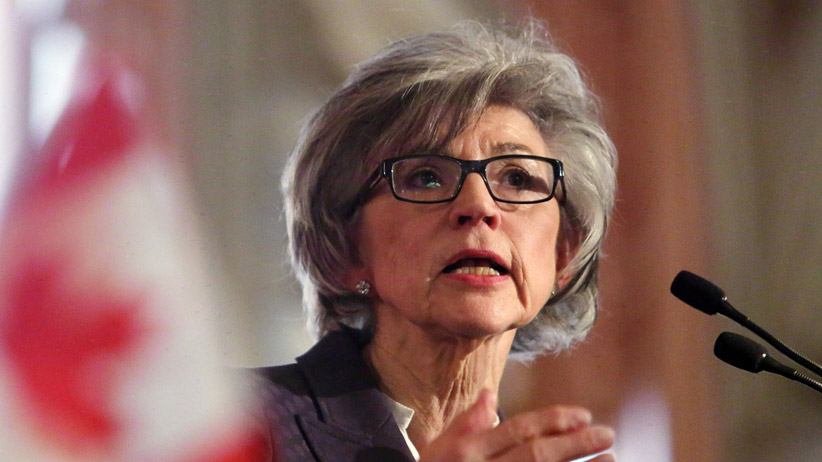Victims of communism-memorial designs worried Chief Justice
Letter from Chief Justice Beverley McLachlin flags memorial’s potential ‘bleakness and brutalism’
Beverly McLachlin, Chief Justice of the Supreme Court of Canada, delivers a speech in Ottawa, Tuesday, February 5, 2013. McLachlin insisted Friday there was nothing wrong with how she and her office consulted with the federal government regarding a presumptive nominee to the high court’s ranks. CREDIT: Fred Chartrand/CP
Share

Chief Justice Beverley McLachlin expressed grave concerns last fall about the shortlisted designs for an imposing memorial to the victims of communism, which the Conservative government plans to install next to her beloved Supreme Court of Canada building. In a letter obtained by Maclean’s, McLachlin complained that designs in contention were too grim for the prominent site. “Regrettably, some of the proposed designs for the memorial could send the wrong message within the judicial precinct, unintentionally conveying a sense of bleakness and brutalism that is inconsistent with a space dedicated to the administration of justice,” she said.
McLachlin’s letter to the deputy minister of Public Works and Government Services is dated Sept. 8, 2014. Three months later, on Dec. 11, the Conservative government announced that its selection jury had chosen the entry from Toronto’s ABSTRAKT Studio Architecture firm, whose winning design features angular concrete rows, rising to 14.5 m in height, covered with what the designers describe as more than a hundred million “memory squares,” each representing a victim of communist regimes. A spokesman for the Supreme Court declined to comment on McLachlin’s letter, so it is not clear that the winning design was among those she found bleak and brutal.
However, architect Shirley Blumberg, a founding partner of the prestigious Toronto firm KPMB, and a dissenting member of the design-selection jury, said McLachlin would have been “absolutely correct” if she included the eventual winning concept among those she found so dispiriting. “The quality of the submissions, I thought, were poor,” Blumberg said in an interview. “The one that was selected by the jury was, I think, particularly brutalist and visceral.” (Blumberg has previously spoken out against both the site and the design for the memorial in this Ottawa Citizen article.)
Related: The monumental politics behind Ottawa’s newest memorials
Several prominent architects and urban planners have voiced their concerns about the memorial, including University of British Columbia’s Larry Beasley, Vancouver’s retired director of planning, and one of the most respected figures in Canadian urban planning circles. Opposition to the sprawling memorial focused, at first, mainly on the Tory government’s decision to put it on a rare vacant site, just west of the Parliament Buildings, previously designated for a future Federal Court of Canada building. But the design itself has also come in for criticism. In this earlier story, Beasley, who chairs the National Capital Commission’s advisory committee on planning, design and realty, said his committee did not favour the winning design.
In her letter to the Public Works deputy minister, McLachlin was cautious not to question the political decision-making behind the memorial. Back in 2012, Public Works transferred the site, between the Supreme Court and the main Library and Archives Canada building, to a private group called Tribute to Liberty, which was formed to push for the memorial. Powerful figures in the government, notably Employment Minister Jason Kenney, enthusiastically backed the group. “I do not comment on the decision to erect a memorial to the victims of communism or on the placement of the memorial; that is for the government to decide,” McLachlin wrote, but added: “However, because the proposed ground of the memorial will be within the judicial precinct, I would ask your department and the selection committee to ensure that the final design is consistent with, and enhances, the public’s respect for justice and the rule of law.”

While McLachlin did not wade in on the issue of the memorial’s location in her letter, she seems to have been more enthusiastic about the earlier plan—cancelled by the Tories—to put a new federal court building on the site. In a talk she gave last Nov. 25 at an Ottawa chamber of commerce breakfast, McLachlin praised the beauty of the Supreme Court’s art deco-influenced building, designed by the renowned Montreal architect Ernest Cormier and completed in 1940, and also the neighbouring justice building, completed in 1938 in the “château” style familiar to Canadians from the era’s railway hotels. She went on to discuss how those two existing buildings relate to the memorial’s proposed site:
“Then, the idea was that the Supreme Court of Canada building . . . would be at the apex of a triangle that would be made by the justice building, the Supreme Court of Canada building, and some other justice-associated building on the western end, where there is now a car park. And a previous government, some of you would know, had planned to put a beautiful building, which was designed by an eminent architect, for the Federal Court of Canada there. But those plans have been scrapped and, presently, the intention is, of the present government, to put a monument there, a large monument, to the victims of communism. So we’ll see whether that will proceed.”
In fact, the memorial now seems all but certain to proceed. The government has announced that construction of “major elements” will be completed and ready for inauguration some time next fall, which means most of the work would be done before the Oct. 19 date slated for the next federal election. The government has committed $3 million to the project. Tribute to Liberty is raising millions more, partly by offering those who donate at least $1,000 the chance to “forever memorialize the name of a loved one” on a wall to be incorporated into the memorial complex.